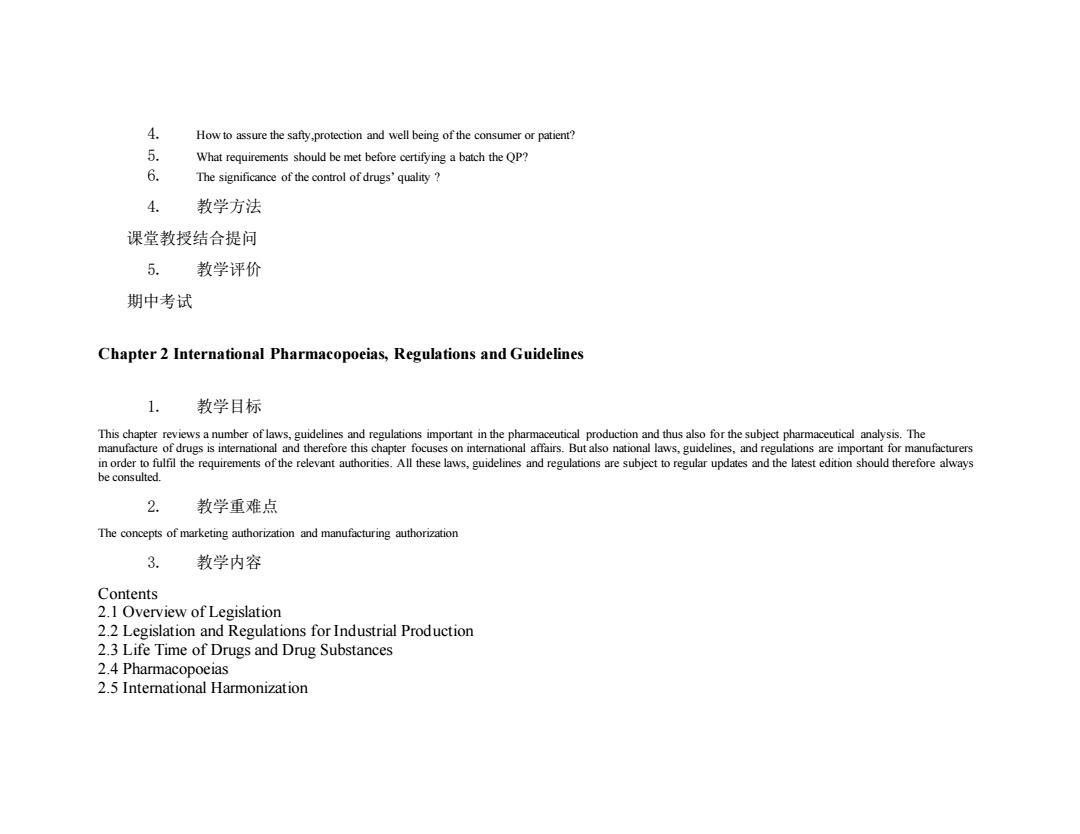
4. How to assure the safty,protection and well being of the consumer or patient? 5. What requirements should be met before certifying a batch the QP? 6. The significance of the control of drugs'quality 4. 教学方法 课堂教授结合提问 5. 教学评价 期中考试 Chapter 2 International Pharmacopoeias,Regulations and Guidelines 1. 教学目标 This chapter reviews a number of laws,guidelines and regulations important in the pharmaceutical production and thus also for the subject pharmaceutical analysis.The manufacture of drugs is international and therefore this chapter focuses on interational affairs.But also national laws,guidelines,and regulations are important for manufacturers in order to fulfil the requirements of the relevant authorities.All these laws,guidelines and regulations are subject to regular updates and the latest edition should therefore always be consulted. 2. 教学重难点 The concepts of marketing authorization and manufacturing authorization 3. 教学内容 Contents 2.1 Overview of Legislation 2.2 Legislation and Regulations for Industrial Production 2.3 Life Time of Drugs and Drug Substances 2.4 Pharmacopoeias 2.5 International Harmonization
4. How to assure the safty,protection and well being of the consumer or patient? 5. What requirements should be met before certifying a batch the QP? 6. The significance of the control of drugs’ quality ? 4. 教学方法 课堂教授结合提问 5. 教学评价 期中考试 Chapter 2 International Pharmacopoeias, Regulations and Guidelines 1. 教学目标 This chapter reviews a number of laws, guidelines and regulations important in the pharmaceutical production and thus also for the subject pharmaceutical analysis. The manufacture of drugs is international and therefore this chapter focuses on international affairs. But also national laws, guidelines, and regulations are important for manufacturers in order to fulfil the requirements of the relevant authorities. All these laws, guidelines and regulations are subject to regular updates and the latest edition should therefore always be consulted. 2. 教学重难点 The concepts of marketing authorization and manufacturing authorization 3. 教学内容 Contents 2.1 Overview of Legislation 2.2 Legislation and Regulations for Industrial Production 2.3 Life Time of Drugs and Drug Substances 2.4 Pharmacopoeias 2.5 International Harmonization
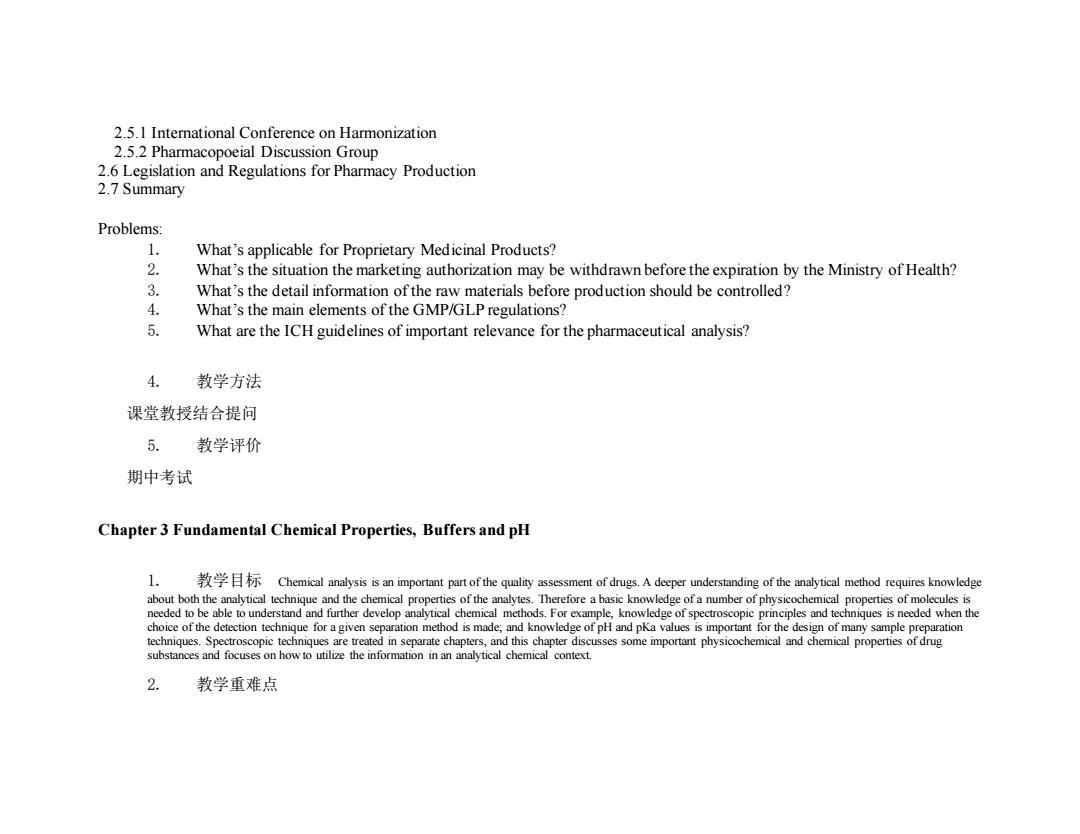
2.5.1 International Conference on Harmonization 2.5.2 Pharmacopoeial Discussion Group 2.6 Legislation and Regulations for Pharmacy Production 2.7 Summary Problems: 1. What's applicable for Proprietary Medicinal Products? 2. What's the situation the marketing authorization may be withdrawn before the expiration by the Ministry of Health? 3. What's the detail information of the raw materials before production should be controlled? 4. What's the main elements of the GMP/GLP regulations? 5. What are the ICH guidelines of important relevance for the pharmaceutical analysis? 教学方法 课堂教授结合提问 5. 教学评价 期中考试 Chapter 3 Fundamental Chemical Properties,Buffers and pH 1. Chemical analysis is an important part of the quality assessment of drugs.A deeper understanding of the analytical method requires knowledge about both the analytical technique and the chemical properties of the analytes.Therefore a basic knowledge of a number of physicochemical properties of molecules is needed to be able to understand and further develop analytical chemical methods.For example,knowledge of spectroscopic principles and techniques is needed when the choice of the detection technique for a given separation method is made;and knowledge of pH and pKa values is important for the design of many sample preparation techniques.Spectroscopic techniques are treated in separate chapters,and this chapter discusses some important physicochemical and chemical properties of drug substances and focuses on how to utilize the information in an analytical chemical context. 2. 教学重难点
2.5.1 International Conference on Harmonization 2.5.2 Pharmacopoeial Discussion Group 2.6 Legislation and Regulations for Pharmacy Production 2.7 Summary Problems: 1. What’s applicable for Proprietary Medicinal Products? 2. What’s the situation the marketing authorization may be withdrawn before the expiration by the Ministry of Health? 3. What’s the detail information of the raw materials before production should be controlled? 4. What’s the main elements of the GMP/GLP regulations? 5. What are the ICH guidelines of important relevance for the pharmaceutical analysis? 4. 教学方法 课堂教授结合提问 5. 教学评价 期中考试 Chapter 3 Fundamental Chemical Properties, Buffers and pH 1. 教学目标 Chemical analysis is an important part of the quality assessment of drugs. A deeper understanding of the analytical method requires knowledge about both the analytical technique and the chemical properties of the analytes. Therefore a basic knowledge of a number of physicochemical properties of molecules is needed to be able to understand and further develop analytical chemical methods. For example, knowledge of spectroscopic principles and techniques is needed when the choice of the detection technique for a given separation method is made; and knowledge of pH and pKa values is important for the design of many sample preparation techniques. Spectroscopic techniques are treated in separate chapters, and this chapter discusses some important physicochemical and chemical properties of drug substances and focuses on how to utilize the information in an analytical chemical context. 2. 教学重难点
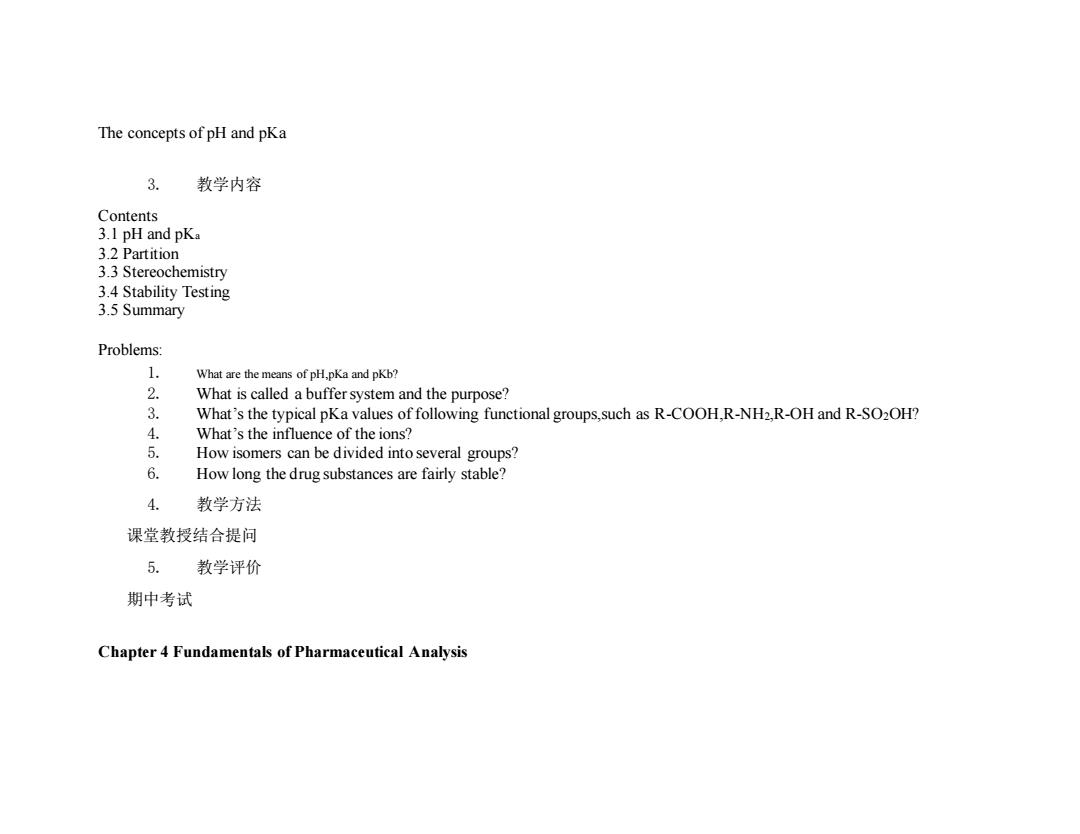
The concepts of pH and pKa 3. 教学内容 Contents 3.1 pH and pKa 3.2 Partition 3.3 Stereochemistry 3.4 Stability Testing 3.5 Summary Problems: 1. What are the means of pH,pKa and pKb? 2. What is called a buffer system and the purpose? 3. What's the typical pKa values of following functional groups,such as R-COOH,R-NH2,R-OH and R-SO2OH? 4. What's the influence of the ions? 5. How isomers can be divided into several groups? 6. How long the drug substances are fairly stable? 4. 教学方法 课堂教授结合提问 5. 教学评价 期中考试 Chapter 4 Fundamentals of Pharmaceutical Analysis
The concepts of pH and pKa 3. 教学内容 Contents 3.1 pH and pKa 3.2 Partition 3.3 Stereochemistry 3.4 Stability Testing 3.5 Summary Problems: 1. What are the means of pH,pKa and pKb? 2. What is called a buffer system and the purpose? 3. What’s the typical pKa values of following functional groups,such as R-COOH,R-NH2,R-OH and R-SO2OH? 4. What’s the influence of the ions? 5. How isomers can be divided into several groups? 6. How long the drug substances are fairly stable? 4. 教学方法 课堂教授结合提问 5. 教学评价 期中考试 Chapter 4 Fundamentals of Pharmaceutical Analysis
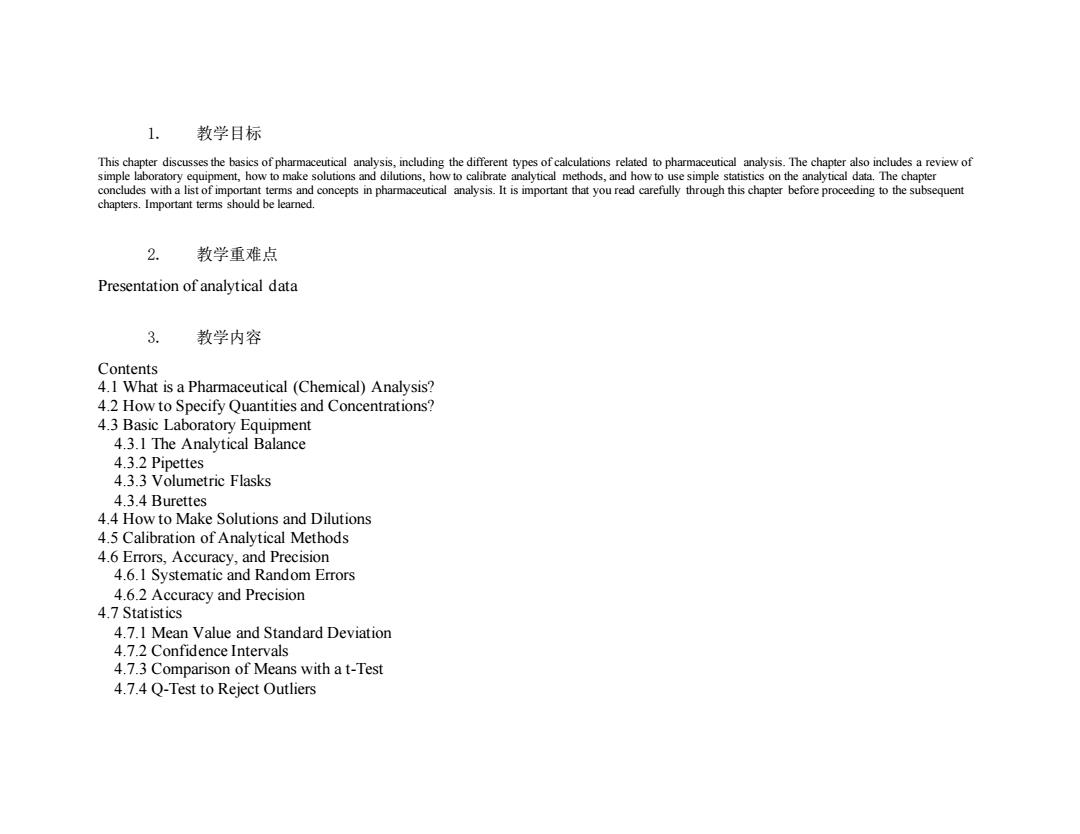
1. 教学目标 This chapter discusses the basics of pharmaceutical analysis,including the different types of calculations related to pharmaceutical analysis.The chapter also includes a review of simple laboratory equipment,how to make solutions and dilutions,how to calibrate analytical methods,and how to use simple statistics on the analytical data.The chapter concludes with a list of important terms and concepts in pharmaceutical analysis.It is important that you read carefully through this chapter before proceeding to the subsequent chapters.Important terms should be learned. 2. 教学重难点 Presentation of analytical data 3. 教学内容 Contents 4.1 What is a Pharmaceutical (Chemical)Analysis? 4.2 How to Specify Quantities and Concentrations? 4.3 Basic Laboratory Equipment 4.3.1 The Analytical Balance 4.3.2 Pipettes 4.3.3 Volumetric Flasks 4.3.4 Burettes 4.4 How to Make Solutions and Dilutions 4.5 Calibration of Analytical Methods 4.6 Errors,Accuracy,and Precision 4.6.1 Systematic and Random Errors 4.6.2 Accuracy and Precision 4.7 Statistics 4.7.1 Mean Value and Standard Deviation 4.7.2 Confidence Intervals 4.7.3 Comparison of Means with a t-Test 4.7.4 Q-Test to Reject Outliers
1. 教学目标 This chapter discusses the basics of pharmaceutical analysis, including the different types of calculations related to pharmaceutical analysis. The chapter also includes a review of simple laboratory equipment, how to make solutions and dilutions, how to calibrate analytical methods, and how to use simple statistics on the analytical data. The chapter concludes with a list of important terms and concepts in pharmaceutical analysis. It is important that you read carefully through this chapter before proceeding to the subsequent chapters. Important terms should be learned. 2. 教学重难点 Presentation of analytical data 3. 教学内容 Contents 4.1 What is a Pharmaceutical (Chemical) Analysis? 4.2 How to Specify Quantities and Concentrations? 4.3 Basic Laboratory Equipment 4.3.1 The Analytical Balance 4.3.2 Pipettes 4.3.3 Volumetric Flasks 4.3.4 Burettes 4.4 How to Make Solutions and Dilutions 4.5 Calibration of Analytical Methods 4.6 Errors, Accuracy, and Precision 4.6.1 Systematic and Random Errors 4.6.2 Accuracy and Precision 4.7 Statistics 4.7.1 Mean Value and Standard Deviation 4.7.2 Confidence Intervals 4.7.3 Comparison of Means with a t-Test 4.7.4 Q-Test to Reject Outliers
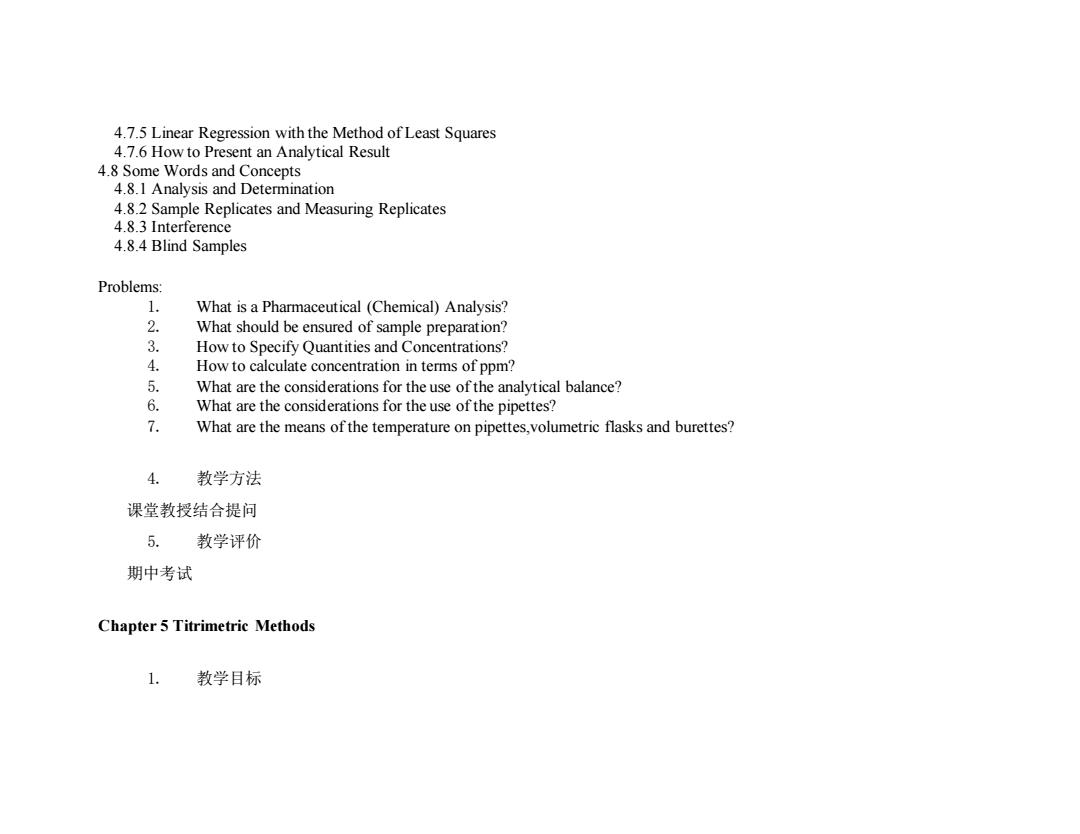
4.7.5 Linear Regression with the Method of Least Squares 4.7.6 How to Present an Analytical Result 4.8 Some Words and Concepts 4.8.1 Analysis and Determination 4.8.2 Sample Replicates and Measuring Replicates 4.8.3 Interference 4.8.4 Blind Samples Problems: 1. What is a Pharmaceutical (Chemical)Analysis? 2. What should be ensured of sample preparation? 3. How to Specify Quantities and Concentrations? 4. How to calculate concentration in terms of ppm? 5. What are the considerations for the use of the analytical balance? 6. What are the considerations for the use of the pipettes? 7. What are the means of the temperature on pipettes,volumetric flasks and burettes? 4. 教学方法 课堂教授结合提问 5. 教学评价 期中考试 Chapter 5 Titrimetric Methods 1. 教学目标
4.7.5 Linear Regression with the Method of Least Squares 4.7.6 How to Present an Analytical Result 4.8 Some Words and Concepts 4.8.1 Analysis and Determination 4.8.2 Sample Replicates and Measuring Replicates 4.8.3 Interference 4.8.4 Blind Samples Problems: 1. What is a Pharmaceutical (Chemical) Analysis? 2. What should be ensured of sample preparation? 3. How to Specify Quantities and Concentrations? 4. How to calculate concentration in terms of ppm? 5. What are the considerations for the use of the analytical balance? 6. What are the considerations for the use of the pipettes? 7. What are the means of the temperature on pipettes,volumetric flasks and burettes? 4. 教学方法 课堂教授结合提问 5. 教学评价 期中考试 Chapter 5 Titrimetric Methods 1. 教学目标